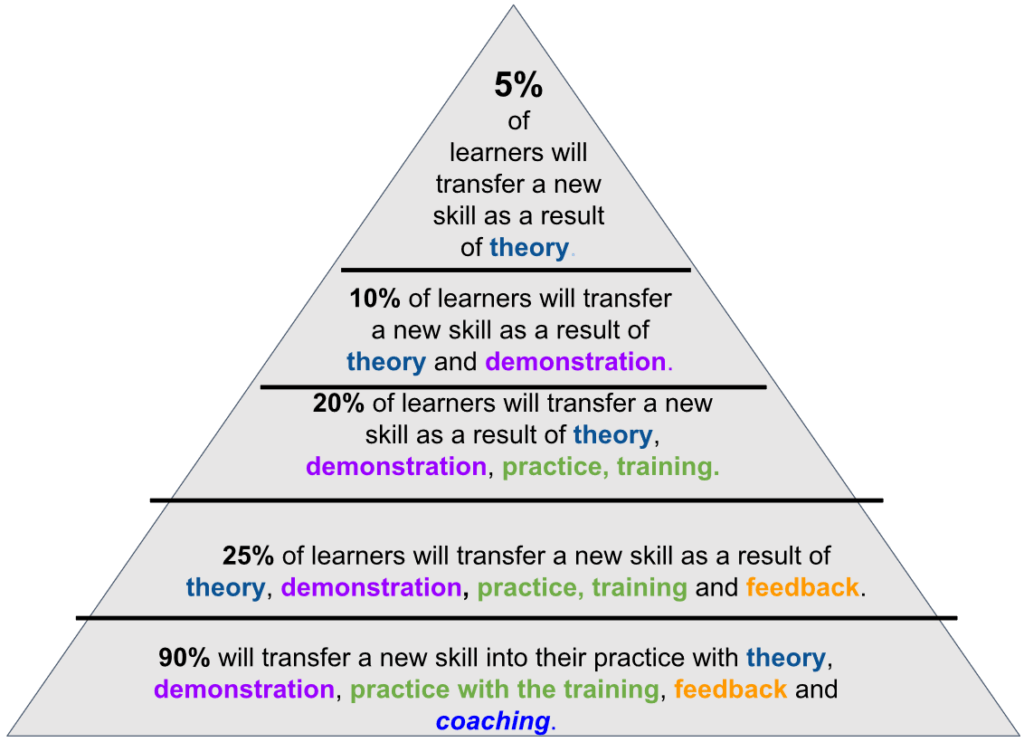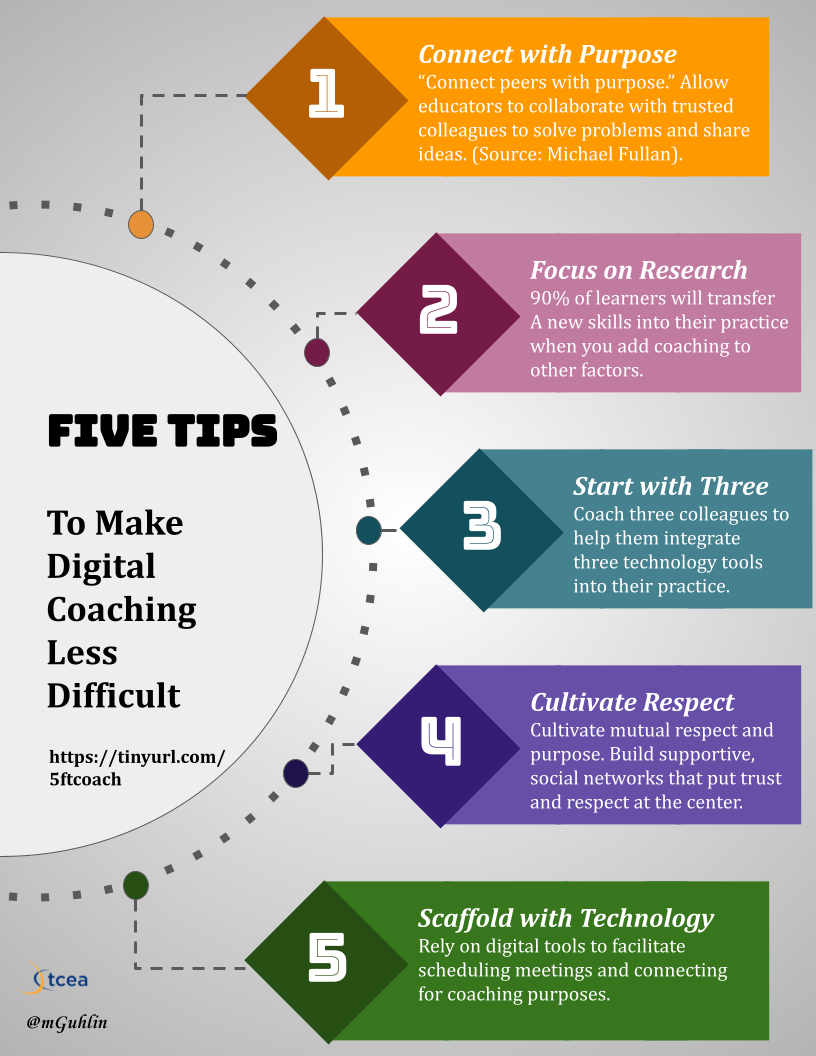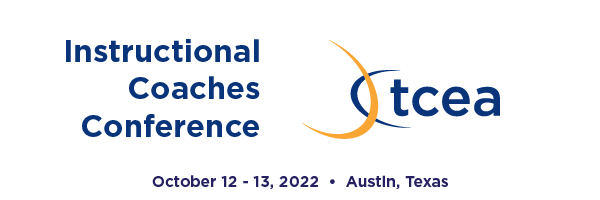“Coaching means side-by-side planning and working together with the same end goal in mind – Learning!” says Dr. Dawn Wilson, co-author of Naturalizing Digital Immigrants: Collegial Coaching for Technology Integration. For many of us, it means coaching from the overflow of wisdom resulting from offering side-by-side assistance. When pondering coaching in the school setting, one of my experiences has been a focus on a more non-technology approach. Some point out that this type of mentor model remains a technology-less experience. Few models encourage technology use, whether to facilitate coaching or model its use to assist teachers or administrators. Let’s explore some key ideas relevant to digital coaching.

Research
Take a moment to absorb the statistics reflected in the above pyramid. Those are pretty sobering stats, right? Given the statistical support for this model of coaching, what road map can schools follow to set up campus communities of technology coaches? As you can see, coaching is THE difference maker when it comes to helping teachers transfer a new skill into their practice. Some other key points:
- Effective professional learning is intensive, ongoing, focused on the classroom, and occurs during the teacher’s workday (Darling-Hammond, 2009).
- To see systemic improvement in student learning and professional learning, we have to “connect peers with purpose.” We must allow educators to routinely collaborate with trusted colleagues to solve problems and share ideas (Source: Michael Fullan, 2008).
Teaching can be a solitary occupation. Although many schools have embraced professional learning communities (PLCs) for collaborative planning to ensure adherence to a district path to state-mandated curriculum standards, teachers can often feel isolated. Let’s explore some key ideas about the power of coaching to address this.
Key Idea #1: Bridge Teachers from Islands of Remoteness
When chatting with teachers, I often hear them speak of having to learn alone. Teacher isolation may be defined as as “a psychological state rather than as a condition of work.”
This orientation [teacher isolated as a psychological state] locates the workplace inside the individual as it is created and continually recreated through the filtering and processing of information (Flinder, 1988). Thus, teacher isolation depends more on how teachers perceive and experience collegial interaction than it does on the absolute amount of interaction in which they are involved (Hedberg, 1981). (Source: English Language Teaching; Vol. 9, No. 5; 2016)
These perceptions of isolation can be overcome with collegial coaching efforts.”With the guidance of a coach, teachers can leverage the power of technology to engage students in their learning and help them develop digital age skills,” says ISTE Standards for Coaches. Dr. Katie Alaniz, co-author of Naturalizing Digital Immigrants: Collegial Coaching for Technology Integration with Dr. Dawn Wilson, shares the following insight from her work. Key concepts are paraphrased below. Listen to the complete audio recording of Dr. Alaniz.
Students are required to coach three colleagues to help them integrate three technology tools. It is absolutely incredible to witness…the confidence boost for teachers who are having trouble. . .this is key. Collegial coaching takes place between colleagues or peers. This sets it apart from other appraisal methods. . .Mutual respect is a key ingredient. When peers coach peers, participant’s communications come more naturally than if they happened with a superior. Supportive, social networks come to life.
Collegial coaching offers an alternative to the more traditional approach. What’s more, it removes the fog of psychological isolation that can demoralize and harm teachers’ forward progress.
View or Get a copy in Google Slides format
Key Idea #2: The Power to Change
“Learners need a little more than just their own personal motivation (help them love what they hate) and coaching on ability (help them do what they can’t)” say the authors of Influencer. A teacher will blend technology into instruction when they have access to coaching. Without coaching, change is difficult. These statistics illustrate that point:
- Eighty-five percent of corporate change efforts fail – Arthur D. Little
- Two out of three criminals are rearrested within three years – U.S. Dept. of Justice
- Two years after receiving coronary bypass surgery to save their lives, 90 percent of patients are back to old behaviors – Dr. Edward Miller, John Hopkins University.
“Rather than attending one-size-fits all professional development sessions, teachers need more strategies for joining with colleagues in supporting one another’s growth in hands-on, authentic working relationships,” says Dr. Katie Alaniz. We do not change alone. We must make change possible in three dimensions: 1) personal; 2) social and 3) structural. Bringing about change involves adopting new skills and approaches.
Key Idea #3 – Adopting a New Set of Skills

Source: Options to Advice (which may be considered “toxic”) and Being Directive, Results Coaching Global
When you consider how difficult changing oneself is, it’s important for coaches to appreciate all the factors. In Results Coaching book, mentors are described as adopting a set of skills that include:
- Creating an environment and scaffolding for thinking in new ways
- Creating environments where deep thinking is sought and valued
- Facilitating processes of dialogue for deep thinking and expanding one’s insights and experience from different points of view
- Presuming positive intent
- Amplifying strengths and successes of others
- Communicating clarity of visions and goals and supports the success of all who take up the call
- Holding up the standards and expectations of the profession to guide solutions and decisions
- Respecting other values, models, and assumptions as effects of experience and knowledge
- Believing in the best self that is within each of us
- Using language of appreciation, respect, possibility, and
- Setting clear expectations and outcomes.
Coaches that adopt these skill sets empower educators to change. As you can see, this type of approach goes beyond two people building a collegial relationship. It involves addressing the six sources of influence represented in Influencer.
Key Idea #3: Technology Tips for Facilitating Coaching
If coaching is more than just about a charismatic coach and willing participant, logistics plays a key part in the change effort. Below are two tips that describe ways that technology can provide assistance to coaches.
Tip #1 – Scheduling Sessions
Want to enable your coaches to schedule meeting times with you on their own? Take advantage of one of these Google/Microsoft calendar-friendly tools to enable others to schedule themselves. Make sure that you schedule your time as well. Don’t forget to set aside time for travel, lunch, and office time. Once others know they can book you for just-in-time support, they will be eager to take advantage of you!
- You Can Book Me: Provides a variety of scheduling features to make setting up meetings easy.
- Assistant.to: This is a Chrome extension that integrates with Google Calendar, letting you schedule meetings right from your compose window.
- Doodle: Doodle offers a selection of solutions that simplify scheduling appointments.
Tip #2 – Virtual Coaching
Virtual coaching, or coaching at a distance, simply means that you and your mentee are in different locales. This could certainly be the case in large districts or when coaching needs require a quick session that can be facilitated via virtual means. Some points to keep in mind:
- Choose what’s right for the situation.
- Text-based tools work for conveying information, but not much else. Video may work well but be distracting in certain situations. Audio works well.
- Find a place that is private and minimizes distractions so you can both focus.
- As coach, manage the time of the virtual coaching session.
Some tools that work include Google Hangouts and Meet, Microsoft’s Skype, and Slack with Appear.In.
Learn More About Coaching Models
Ready to learn more about coaching models? Many of us imagine the process of helping another educator to be quite straightforward. Coaching, though, is more than just showing or telling people how to do things. While collegial coaching (briefly touched on in this blog entry) is one approach you can learn about that blends technology into coaching, there are others available. Results Coaching is one model that is in use in Texas districts. Dr. Elena Aguilar’s book, The Art of Coaching, also provides guidance and insight. Jim Knight’s work, Instructional Coaching: A Partnership Approach to Improving Instruction, is also recommended.


